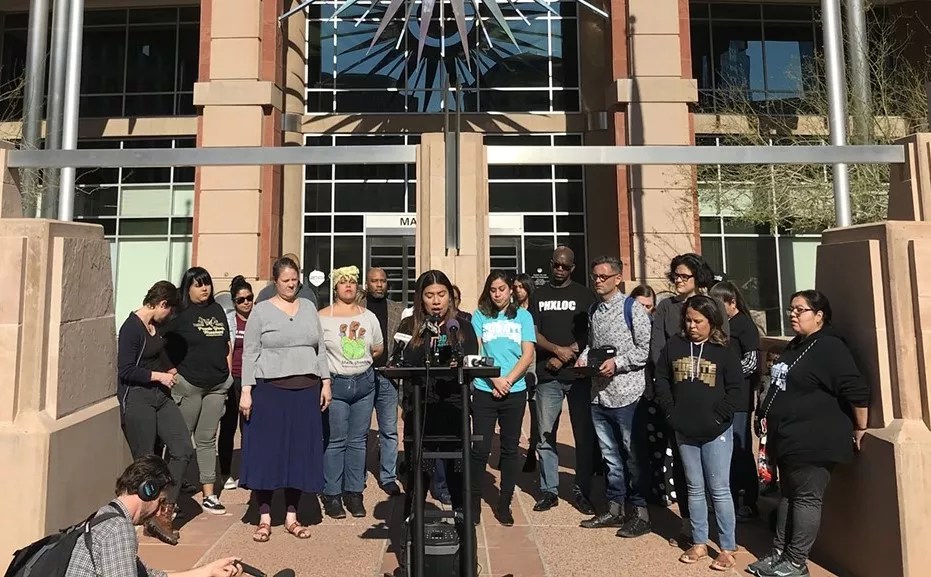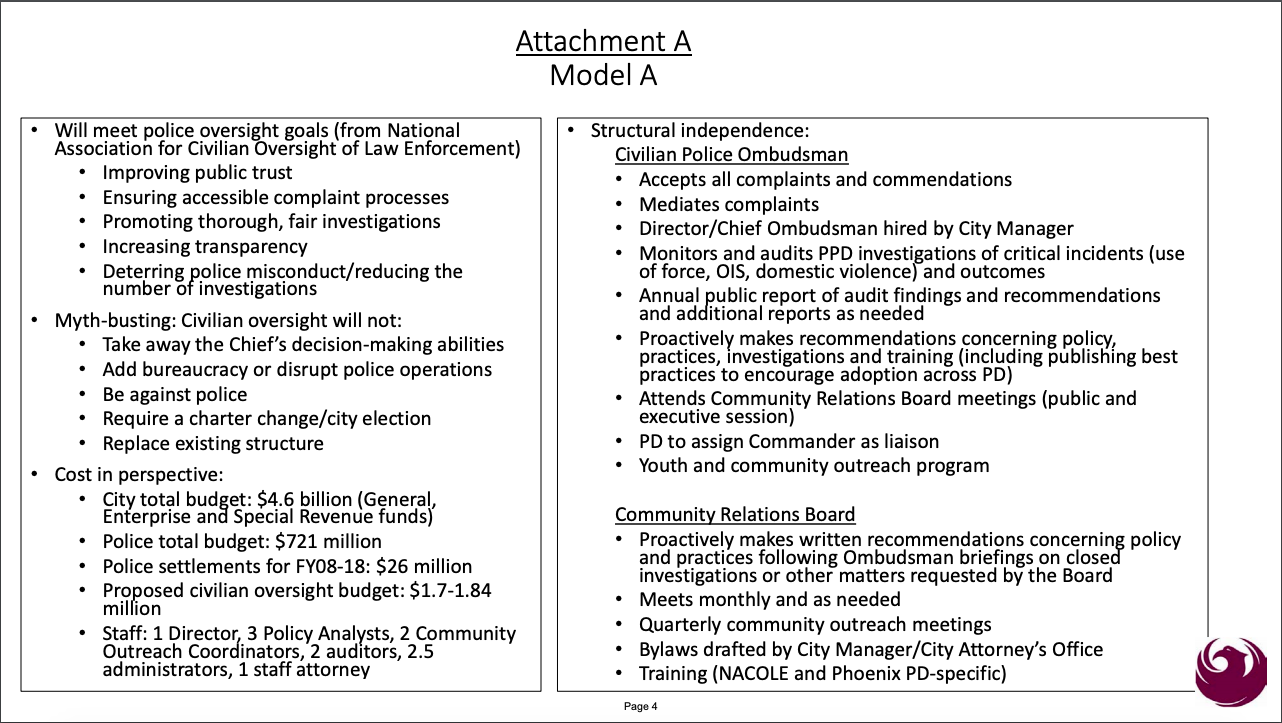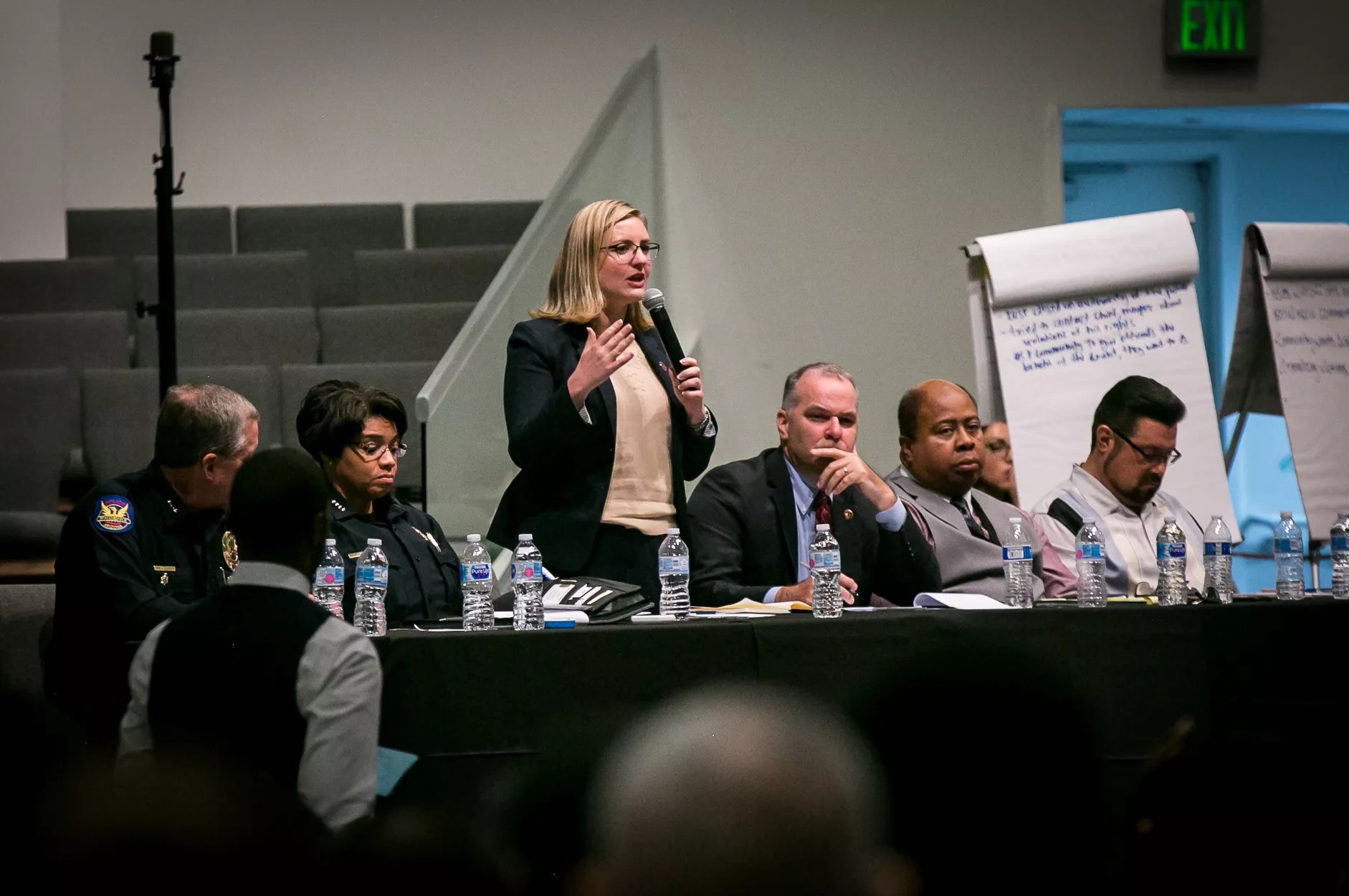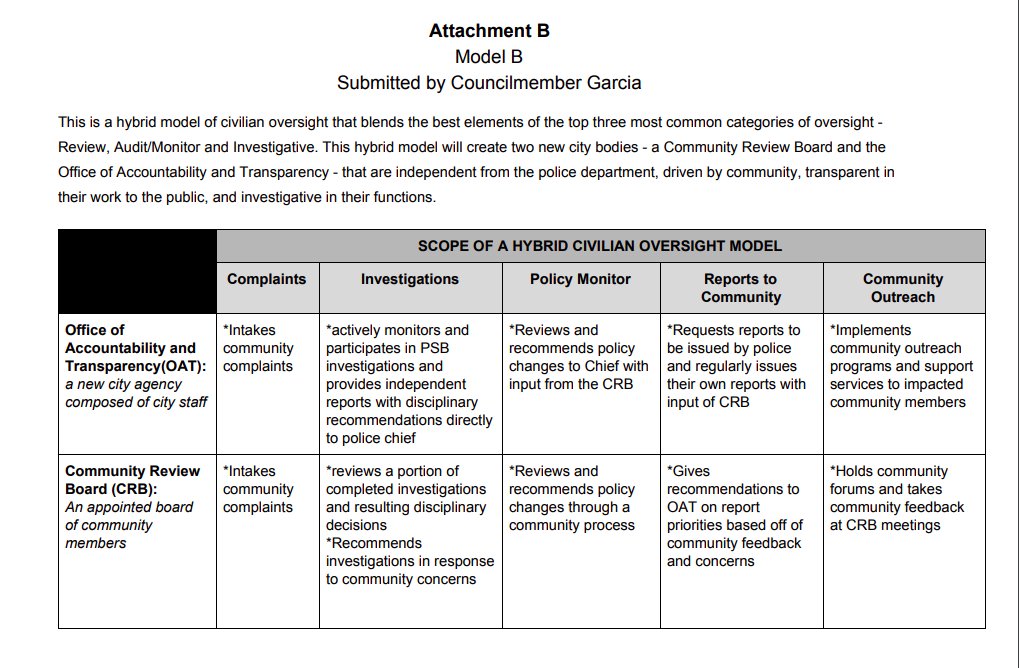
Meg O’Connor

Audio By Carbonatix
(Update: In a surprising turn of events, Gallego withdrew support for her own proposal at the last second. Read more about how it all went down here.)
The city of Phoenix will take one step closer today to creating a new city agency to oversee the Phoenix Police Department. At 2:30 p.m., the City Council will meet to discuss – and possibly vote on – which model of civilian oversight Phoenix will adopt.
Calls for civilian oversight of the Phoenix Police Department had been years in the making, but reached a tipping point last June when back-to-back high-profile incidents brought national scrutiny to the department. The viral video of a Phoenix cop threatening to shoot an unarmed black man in the head in front of his children, and news that dozens of Phoenix police officers had shared racist, Islamophobic content on Facebook, came on the heels of a record-high number of police shootings. Currently, Phoenix is the largest city in the nation without independent oversight of police.
One week after the viral video’s release, community members pressured City Council members not to pass this year’s $721 million budget for the police department without adopting a civilian review board. Mayor Kate Gallego then agreed to call a special meeting on police reform.
This year, make your gift count –
Invest in local news that matters.
Our work is funded by readers like you who make voluntary gifts because they value our work and want to see it continue. Make a contribution today to help us reach our $30,000 goal!
After about eight months of public and private talks on how to bring civilian oversight of the police department to Phoenix, two models for civilian oversight have been put forward – one by Gallego and another by District 8 Council Member Carlos Garcia. The two models share many of the same elements but differ greatly when it comes to investigative powers and independence from the police department, which are two key elements that many community members have demanded.
It’s unclear which way the Council will vote, if they vote today. Though a group of community members spent Monday morning, and the past several months, demanding that Gallego support an independent, investigative model of civilian oversight, it’s clear from an hourlong interview with Gallego, her communications director, and a policy adviser that such support isn’t coming.
At the same time, Garcia’s unlikely to budge on his proposal. The council member told the Arizona Republic that he would not support Gallego’s model because it “doesn’t have an investigative component that would hold police accountable.”
Garcia did not respond to requests from Phoenix New Times to explain his proposal.
Gallego didn’t say how many votes she thought her proposal had, while Garcia told the Republic he believed his model has enough votes to pass – if Gallego supports it.
Garcia’s model, which was developed with significant input from community groups like Puente Human Rights Movement (where Garcia used to work) and Poder in Action, is a hybrid model of civilian oversight that combines the powers of the three most common oversight models: review powers, auditing/monitoring powers, and investigative powers.
Gallego’s model takes a more middle-of-the-road approach while still retaining more power than the slipshod list of bullet points included in the City Council agenda late last Friday would imply. It’s an auditing/monitoring model, which puts an emphasis on monitoring the citizen complaint process from start to finish and identifying trends and patterns in the police department’s handling of citizen complaints.

Gallego’s model
Phoenix City Council
At a press conference outside City Hall on Monday morning, some community members lambasted Gallego’s model as a “fake proposal,” “weakened enough that it’s just for show” due to pressure from the Phoenix police union, and something that “completely ignores the thousands of people demanding transparency and accountability from the Phoenix Police Department and does nothing to change the culture of violence and mistrust at the department.”
“Gallego’s model ignores the pain of mothers whose children have been killed by police, who have demanded independent and transparent investigations,” said Estela Varela of Poder in Action on Monday. “The mayor’s proposal will change nothing to the current process that allows cops to investigate themselves … We need civilian oversight that can and will hold police accountable through investigations of misconduct that are independent from the police department.”
A meeting with Gallego, her communications director Annie DeGraw, and consultant to the mayor on the civilian oversight process Stephanie Cherny, shed some light on how the mayor came to make the decision that she did, what went into the proposal, and why she believes it’s the best one for Phoenix.
“I am mayor of all 1.7 million Phoenicians. I also represent our 13,000 city employees, including 3,000 police officers. I try to represent everyone and bring people together for a model that will stand the test of time,” Gallego told New Times on Monday. “I think my proposal will help us become a stronger city with a stronger police department. I recognize all the work these groups put in, but I thought it was important to ask, ‘How does this impact all stakeholders?’ I think it was important to sit down with police officers as well. The Phoenix Law Enforcement Association didn’t support my campaign, but I want to be mayor for everyone in this city and not just the people that support me.”
Gallego’s Model
Under Gallego’s proposal, the city would create a Civilian Police Ombudsman and a Community Relations Board to oversee the Phoenix Police Department.
The ombudsman would be hired by the city manager following a “robust and public process,” Gallego said, similar to how the city hired Phoenix Police Chief Jeri Williams. For the chief’s hire, the city held several community meetings to seek input from stakeholders, surveyed the community, searched nationally to recruit a candidate, publicized a list of semifinalists, had panels of city staff and community members interview those semifinalists, whittled it down to a few top finalists, and allowed the community to interview the three finalists at a public forum.
The ombudsman’s office would include additional staff members (three policy analysts, two community outreach coordinators, two auditors, two to three administrators, and one staff attorney). The selection pool and process for those additional staff members is something that will be decided upon at a later date during future City Council meetings as discussions on civilian oversight continue. Who will be chosen from where for the Community Relations Board and how they will be selected will also be determined at a later date.
The ombudsman’s office would create a new place for citizens to go when making complaints (or recommendations) about Phoenix police officers. However, it would not replace the department’s Professional Standards Bureau, which currently receives and investigates citizen complaints; it would simply add another avenue for complaints. The ombudsman’s office would accept all complaints in the sense that there is no threshold or limit on what a citizen could complain about (i.e., the office would take complaints about officer rudeness).
Adopting a model used by several other cities, including Denver, Gallego chose to put forth a civilian oversight model that allows the oversight body to mediate complaints it receives, should residents chose to go the route of mediation.
Mediation would involve a meeting between the complainant and the officer whose actions they are complaining about, facilitated by a neutral mediator who tries to talk them through the issue. Cherny, Gallego’s policy adviser on the civilian review process, described it was a way to informally open up a dialogue between the community and police.
“In some cases, what residents want is to be able to be heard and tell their side of the story. Denver had had very good luck – I believe 85 percent of people who went through the mediation process felt it was a useful, successful tool,” Gallego said. “But we understand that there’s some people for whom that’s not what their goal is … One path forward would be mediation, and that is only in our model.”

Mayor Kate Gallego speaks at a community meeting called in reaction to the back-to-back high-profile incidents in June.
Melissa Fossum
Perhaps the model’s greatest strength when it comes to catching police misconduct or creating any meaningful policy change at the Phoenix Police Department lies in its ability to monitor and audit the department’s investigations of critical incidents and to audit other types of citizen complaints, identify trends, and suggest changes.
In 2018, Phoenix police received 467 calls from citizens complaining about officer behavior. The Professional Standards Bureau (PSB) conducted an “inquiry” into 438 of those (inquiries are a step below a full investigation and complaints can sometimes be resolved during the inquiry phase, according to a City Council agenda with information on citizen complaints). PSB ultimately conducted 105 full investigations into officer misconduct in 2018.
Of those, relatively few would rise to the level of critical incidents meeting the criteria for review as outlined in Gallego’s proposal, since officer misconduct can include a range of inappropriate behaviors and not just officer involved shootings, high-profile incidents, or domestic violence.
But when asked whether those three types of incidents are the only ones the ombudsman’s office would review, Cherny said the office would be tracking every single complaint that comes in, whether to the office, PSB, or elsewhere, to at least monitor and identify trends in what types of complaints are being made and what the outcomes of those complaints are. Additionally, should the ombudsman’s office identify a number of similar complaints that deserve a closer look, it would be within its power to audit those investigations in full as well, even if they did not rise to the level of a critical incident, officer-involved shooting, or domestic violence.
“Let’s say there were a number of rudeness complaints in a certain precinct that PSB decided not to open,” Cherny said. “The auditor could say, ‘You know what, we’re seeing a trend here of rudeness complaints in this precinct; maybe we need customer service training in this precinct.'”
Cherny said the goal is not to have the ombudsman’s office review in full each of the hundreds of complaints that police receive annually but rather, to audit the complaints “that are of the highest community touch points, without limiting their ability to track systemic trends in what’s being complained about.”
Gallego’s Model Isn’t Investigative
Community members, via coalitions like the Phoenix Civilian Oversight Coalition, repeatedly have called for a civilian oversight body that is independent, investigative, transparent, and community-driven. Gallego’s model doesn’t hit all the marks: The police department will assign a commander as a liaison to the ombudsman’s office, meaning the office would not be completely independent from the police department. The model also lacks the ability for the oversight body to investigate citizen complaints itself.
Currently, when a citizen complains about misconduct from a police officer, the police department investigates. Given that only about 100 of nearly 450 citizen complaints were even investigated in 2018, and that police officers are incentivized to protect each other, it’s more than possible that some citizen complaints are not given full and thorough investigations. Occasionally, police officers will attempt to shield others from misconduct investigations by talking citizens out of a complaint; by making it difficult for citizens to follow through with the complaint process; by failing to fully investigate the complaint by contacting all parties involved; or by deciding to include or exclude information from investigative reports in a way benefits the officer accused of misconduct.
This is why community members are calling for a civilian oversight body with the ability to investigate misconduct itself, independent of the Professional Standards Bureau.
Under Garcia’s model, a new city agency, the Office of Accountability and Transparency, which would be composed of city staff, would actively monitor and participate in PSB investigations and would provide independent reports with recommendations on discipline to the chief. Garcia’s model also would establish a Community Review Board which would review completed PSB investigations and the resulting disciplinary action, and could recommend investigations to be carried out in response to concerns from members of the community.

Garcia’s model
Phoenix City Council
Under Gallego’s model, the ombudsman’s office would have the ability to observe and monitor certain PSB investigations “to the extent he or she feels necessary,” Cherny said. Meaning, if the auditor thought they needed to watch interviews during the investigation in real time, or recommend PSB interview additional witnesses during the process, they could, though they could also opt to simply review the written investigation after it is concluded.
Asked why she chose not to go with an investigative model, Gallego said that in deciding what model would work best for the city of Phoenix, she met with stakeholders from all sides, including victims of police violence, police officers, police unions, academics, the Department of Justice, the National Association for Civilian Oversight of Law Enforcement, and several other mayors who have created civilian oversight bodies in their cities.
“To me, this model was very forward-looking and results-focused, addressing solutions, and it was also fair,” Gallego said. “I think that when you have broader groups at the table and more perspectives, including from people who have been on all sides of the issue, you can get to better policy outcomes.”
While the calls for independent, investigative oversight of the Phoenix police department have been loud and persistent from some community members, DeGraw pointed out that many stakeholders don’t want any additional police oversight at all.
“I still can’t see what a civilian review board would correct in our current system,” PLEA President Britt London said in a City Council meeting in November. “There’s no need to reinvent the wheel.”
Gallego also expressed concern that under Garcia’s model, the oversight body and the PSB would conduct separate investigations and may send different recommendations on discipline to the chief, forcing the Phoenix police chief to constantly side with either the department or the community. One of Gallego’s main goals with her civilian oversight model is to repair the trust between the community and the Phoenix Police Department, something she fears would be far more difficult to do with Garcia’s model.
With either model, the decision on discipline ultimately rests with the chief. Still, under Garcia’s model, misconduct investigations are likely to be more frequent, more thorough, and result in more serious recommendations on discipline than the current process at the Phoenix Police Department does.
By creating a new agency with the power to monitor and participate in PSB investigations, Garcia’s model seeks to avoid some of the current pitfalls of PSB investigations: that not all citizen complaints lead to an investigation, and that some investigations are not conducted thoroughly.
And recent history at the Phoenix Police Department has shown that even when the Disciplinary Review Board recommends discipline for extremely high-profile incidents of misconduct, like the viral video incident from last June, it can sometimes be just a slap on the wrist.
“The DRB recommended [Chris Meyer, the officer from the viral video] receive a six-week, unpaid suspension. But the decision on discipline is mine,” Williams said at a press conference announcing her decision to terminate Meyer in October. “In this case, a 240-hour suspension is just not sufficient to reverse the adverse effects of his actions on our department and our community.”